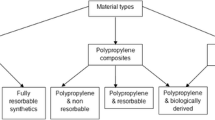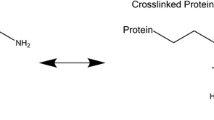Abstract
Synthetic suburethral slings have recently become popular despite the risk of erosion commonly associated with synthetic implants. Some of these materials seem to have unexpectedly low erosion rates. Based on the hypothesis that erosion is due, in part, to biomechanical properties, we undertook an in vitro study. The biomechanical properties of eight non-resorbable synthetic implant materials, stiffness (slope, N/mm) and peak load (N) were determined from load vs. displacement curves. Open-weave Prolene mesh showed unique biomechanical properties compared to other tested materials. The tension- free vaginal tape had the lowest initial stiffness (0.23 N/mm), i.e. low resistance to deformation at forces below the elastic limit, whereas the stiffest implant tested, a nylon tape, reached 6.83 N/mm. We concluded that the TVT and other wide-weave Prolene tapes have unique biomechanical characteristics. These properties may be at least partly responsible for the apparent clinical success of the implants.




Similar content being viewed by others
References
Iglesia CB, Fenner DE, Brubaker L (1997) The use of mesh in gynecologic surgery. Int Urogynecol J 8:105–115
Fenner DE (2000) New surgical mesh. Clin Obstet Gynecol 43:650–658
Ulmsten U, Johnson P, Rezapour M (1999) A three-year follow up of tension free vaginal tape for surgical treatment of female stress urinary incontinence. Br J Obstet Gynaecol 106:345–350
Olsson I, Kroon UB (1999) A three year postoperative evaluation of tension-free vaginal tape. Gynecol Obstet Invest 48:267–269
Moran PA, Ward KL, Johnson D, Smirni WE, Hilton P, Bibby J (2000) Tension-free vaginal tape for primary genuine stress incontinence: a two-centre follow-up study. BJU Int 86:39–42
Schumpelick V, Klinge U, Welty G, Klosterhalfen B (1999) Meshes within the abdominal wall (in German). Chirurgie 70:876–887
Stanton S (2001) Some reflections on tension-free vaginal tape – a new surgical procedure for treatment of female urinary incontinence. Int Urogynecol J 12 [Suppl 2]:S1–2
Dietz HP, Mouritsen L, Ellis G, Wilson PD (2003) How important is TVT location? Acta Obstet Gynecol Scand (in press)
Falconer C, Soederberg M, Blomgren B, Ulmsten U (2001) Influence of different sling materials on connective tissue metabolism in stress urinary incontinent women. Int Urogynecol J 12 [Suppl 2]:S19–23
Acknowledgements
Materials were supplied free of charge. There was no further corporate sponsorship of this study by any manufacturer.
Author information
Authors and Affiliations
Corresponding author
Additional information
Editorial Comment: Understanding the biomechanical properties of synthetic meshes is important in choosing appropriate materials for a variety of urogynecologic procedures, particularly suburethral slings. Although this paper does not address histologic or in vivo findings, the biomechanical properties that seem to be important are mesh pore size, weave and stiffness. Although mesh may be made from similar materials, the final weave of the product may play a role in the ultimate outcomes or complications from slings. Further studies in animal or human models may be necessary to determine the importance of these biomechanical properties.
Rights and permissions
About this article
Cite this article
Dietz, H.P., Vancaillie, P., Svehla, M. et al. Mechanical properties of urogynecologic implant materials. Int Urogynecol J 14, 239–243 (2003). https://doi.org/10.1007/s00192-003-1041-8
Received:
Accepted:
Published:
Issue Date:
DOI: https://doi.org/10.1007/s00192-003-1041-8




